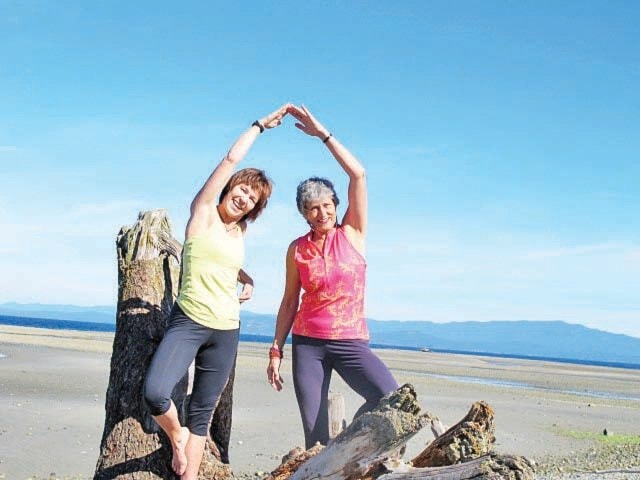They have buzzed the skies over forest fires, hampering the efforts of aircraft and drawing the ire of Premier Christy Clark.
They have crept too close to a pod of orcas in the waters near Vancouver Island, earning a hefty fine for the owner from Washington State authorities.
Another episode of annoyance — or perhaps larger safety and privacy issues — came closer to home recently when an unmanned aircraft equipped with a camera, a drone, disrupted a Yoga on the Beach class with more than 40 participants in Parksville on Aug. 12.
The teachers of this yoga class, Dr. Barbara Low and Charlotte Crowley, have asked the City of Parksville for "enforceable safety bylaws" to prohibit the use of drones in public parks.
"Having a cam-drone buzzing over our class of 40 people was not an ideal experience in August while they attempted to relax after an hour of yoga workout," the women wrote, adding that the incident "put a large group of adults' well-being and comfort at potential risk."
The women said when they asked the youth operating the drone to stop buzzing the group, he said he thought he had permission to play with the device in the park.
"This is not acceptable from a safety perspective, nor is it sensible or legal," Low and Crowley wrote in their letter to the city. "Technology changes, fads flourish and competition leads to affordability of fun things to do with a joystick, but there is no accounting for lack of common sense."
The city, through its Director of Administrative Services Debbie Comis, provided this answer to the yoga teachers in a letter obtained by
The NEWS:
"The regulation of what is referred to as unmanned aircraft, including model planes and drones is under the control of Transport Canada," wrote Comis. "The city does not regulate this type of activity. Your concerns would be better directed to Transport Canada."
However, municipalities in B.C. have taken steps to curb the use of these devices in public places. For example, the City of Richmond banned drones and other remote-controlled aircraft from parks and school grounds in a bylaw it passed in April.
"Richmond is near YVR and has had all sorts of problems with potential interference with the flight patterns of aircraft," said Parksville Mayor Marc Lefebvre. "This is the first type of this complaint we have received. No doubt as the popularity of these devices grows it could become an issue, such as the invasion of privacy. At the present time we need more information on the regulation of these devices before we pass any more bylaws."
Lefebvre said one of the first questions that comes to mind for him is how any new bylaw could be enforced. The mayor also said he is interested in the use of drones in Parksville "for safety and security for the fire department, police department and search and rescue personnel, not to mention staff who monitor the Englishman River banks and the Arrowsmith Dam."
Lefebvre also said he will be pursuing this matter further because "it could become a problem if not properly regulated with a reasonable means to do so."
Whomever buzzed the yoga group, it wasn't likely a member of the PDQ Flyers, the local unmanned aircraft club that has 70 members, three of which own drones, said the Flyers' publicity director Bruce Berry. The Flyers have their own field in Nanoose Bay and stringent national regulations about where and when they operate their craft.
"If anyone is flying drones in that area (Parksville Community Park), they most certainly don't belong to our club," said Berry.
On its website, Transport Canada provides a list of do's and don'ts in regards to operating unmanned aircraft. You don't need permission to fly your unmanned aircraft recreationally if it weighs less than 35 kg (77 pounds), but Transport Canada asks that people read and follow it's safety guidelines.
The 'do' list includes: "Respect the privacy of others – avoid flying over private property or taking photos or videos without permission."
The 'don't fly' list includes:
• Closer than nine km from any airport, heliport, or aerodrome.
• Higher than 90 metres above the ground.
• Closer than 150 metres from people, animals, buildings, structures, or vehicles.
• In populated areas or near large groups of people, including sporting events, concerts, festivals, and firework shows.
• Near moving vehicles, avoid highways, bridges, busy streets or anywhere you could endanger or distract drivers.
• Within restricted airspace, including near or over military bases, prisons and forest fires.
• Anywhere you may interfere with first responders.
Transport Canada also says it intends to introduce regulatory requirements for unmanned air vehicles that weigh 25 kg or less in 2016.
"The goal of these new proposed regulations is to support the enjoyment and development of this budding sector while keeping people on the ground and in the sky safe," Minister of Transport Lisa Raitt said on May 28 of this year.
"I look forward to hearing from our stakeholders as I consult them in the coming months."
